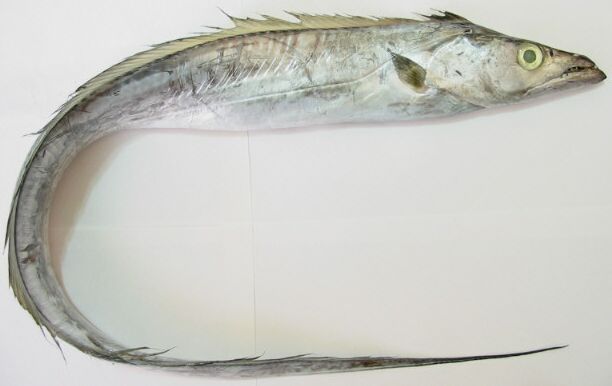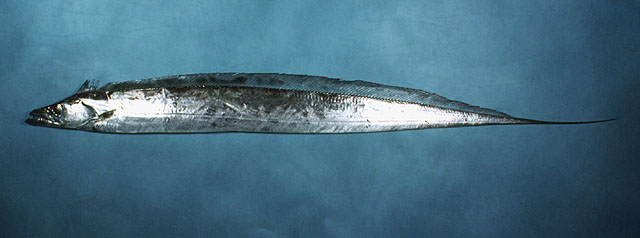
Trichiurus lepturus
FAMILY
Trichiuridae
TAXONOMY
Trichiurus lepturus Linnaeus, 1758, South Carolina.
OTHER COMMON NAMES
English: Atlantic cutlassfish; French: Poisson sabre commun;
Spanish: Pez sable.
PHYSICAL CHARACTERISTICS
Maximum length 47 in (120 cm) total length, commonly
20–39 in (50–100 cm). Body extremely elongate and strongly
compressed, ribbon-like tapering to a point. No caudal fin.
Eye large, contained 5–7 times in head length (head length divided
by eye diameter equals 5–7). Mouth large with a cartilaginous
process at tip of upper and lower jaws. Two or three
pairs of enlarged fangs with barbs near tip of upper jaw and
another pair near tip of lower jaw. Dorsal fin high and long,
no notch between spinous and soft portions, three spines and
130–135 soft rays. Anal fin reduced to 100–105 minute spinules,
usually embedded in the skin. Pectoral fins short; pelvic
fins absent. Vertebrae numerous, 162–168. Fresh specimens
steel blue with silvery reflection, color becoming silvery gray
after death.
DISTRIBUTION
Tropical and temperate marine waters of the world if the eastern
Pacific Trichiurus nitens is regarded as a synonym of T. lepturus
Nakamura and Parin, 1993.
HABITAT
Benthopelagic, continental shelf to 1,148 ft (350 m), occasionally
in shallow waters and at the surface at night.
BEHAVIOR
Juveniles and small adults form schools about 100 m above the
bottom during the daytime and form loose feeding aggregations
at night-time near the surface. Large adults feed on
pelagic prey near the surface during the daytime and migrate
to the bottom at night.
FEEDING ECOLOGY AND DIET
Young and immature fish feed mostly on krill, small planktonic
crustaceans, and small fishes. Adults become more piscivorous
and feed on a wide variety of fishes plus squids and crustaceans.
REPRODUCTIVE BIOLOGY
In the Gulf of Mexico, spawning occurs offshore at depths
greater than 151 ft (46 m). The fish mature at 2 years of age
and a size of approximately 12 in (30 cm) preanal length for females
and 11 in (28 cm) for males. Adult females produce
33,000–85,000 eggs. Eggs are pelagic with a diameter of
0.067–0.074 in (1.7–1.9 mm) and hatch in 3–6 days.
CONSERVATION STATUS
Not threatened.
SIGNIFICANCE TO HUMANS
An important food fish in many parts of the world. FAO catch
statistics for 1991–2000 show catches of 867,145–1,631,253
tons (786,661–1,479,848 metric tons) per year by 44 countries
in 11 FAO fishing areas. Caught with a variety of nets. Also
taken by anglers; the all-tackle world record is an 8-lb (3.7-kg)
fish taken off Rio de Janeiro.
Other popular Animals
Photo Gallery of - Largehead hairtail





 Animalia Life
Animalia Life